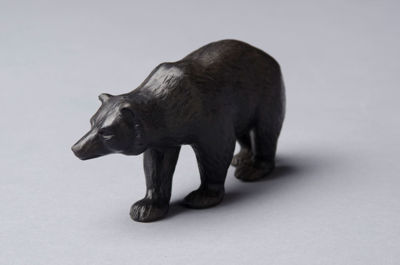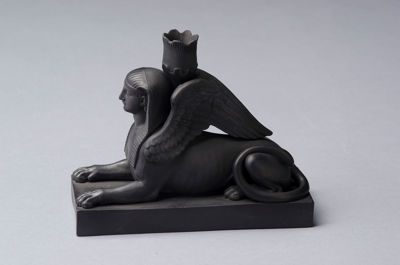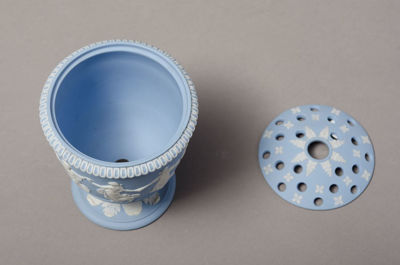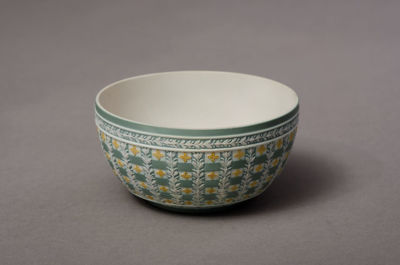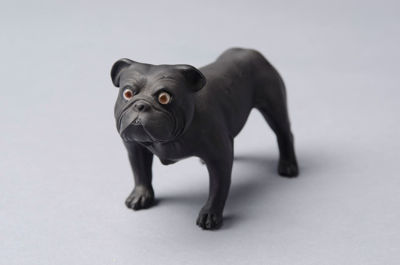Wedgwood
Title: Bear in Black Basalt
Bear from the celebrated English ceramic firm, modeled by Ernest Light and completed in black basalt with distinctive glass eyes in the early 20th century. Josiah Wedgwood introduced into production a black stoneware body in 1768. The first trials for Wedgwood's new black body had begun by July 1766, even before the move to Etruria. By September 1767 his experiments were at an advanced stage, ready for production, and less than twelve months later black basalt wares were on the market. He called it ‘Black Basaltes'; we know it as black basalt. Made from reddish-brown clay which burned black in firing, this ceramic body was superior in its appearance to the local 'Egyptian Black' wares produced in the area prior to that date.
Title: Black Basalt Sphinx Candlestick
Pair of Wedgwood Black Basalt Sphinx-form Candlesticks, England, early 19th century, each with a scalloped-edge candle nozzle mounted atop the back of the seated figure set on a rectangular base, impressed mark Early 19th century sphinx-form candlestick pair, completed in the signature Wedgwood black basalt. Each of the seated figures sits atop a plain rectangular base, the scalloped candlestick chamber resting just behind the head and between the wings to create a balanced and tapered silhouette. This is one of many examples of Wedgwood’s indulgence in recreating classical or historical examples of ceramic and sculpture, and through the periods of the 18th and 19th century the reoccurring sphinx could interchangeably be Greek or Egyptian in origin — or even both, as often the differing cultures were indistinguishable by scholars & collectors of the time.
Title: Black Basalt Sphinx Candlestick
Pair of Wedgwood Black Basalt Sphinx-form Candlesticks, England, early 19th century, each with a scalloped-edge candle nozzle mounted atop the back of the seated figure set on a rectangular base, impressed mark Early 19th century sphinx-form candlestick pair, completed in the signature Wedgwood black basalt. Each of the seated figures sits atop a plain rectangular base, the scalloped candlestick chamber resting just behind the head and between the wings to create a balanced and tapered silhouette. This is one of many examples of Wedgwood’s indulgence in recreating classical or historical examples of ceramic and sculpture, and through the periods of the 18th and 19th century the reoccurring sphinx could interchangeably be Greek or Egyptian in origin — or even both, as often the differing cultures were indistinguishable by scholars & collectors of the time.
Title: Bough Pot - Solid Blue Jasper
Wedgwood Solid Blue Jasper Bough Pot and Cover, England, 19th century, applied white relief with Dancing Hours figures to an orange peel textured ground bordered with foliage, the pierced cover adorned with florets, impressed mark, ht. 5 7/8 in.
Title: Bulldog in Black Basalt
Bulldog from the celebrated English ceramic firm, modelled by Ernest Light and completed in black basalt with distinctive glass eyes in the early 20th century. Josiah Wedgwood introduced into production a black stoneware body in 1768. The first trials for Wedgwood's new black body had begun by July 1766, even before the move to Etruria. By September 1767 his experiments were at an advanced stage, ready for production, and less than twelve months later black basalt wares were on the market. He called it ‘Black Basaltes'; we know it as black basalt. Made from reddish-brown clay which burned black in firing, this ceramic body was superior in its appearance to the local 'Egyptian Black' wares produced in the area prior to that date. Provenance: Property of the Saint Louis Art Museum, Sold to benefit the acquisition fund. Elephant with tusks restored. Bear possibly a later model.

